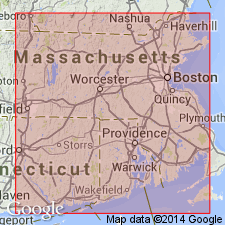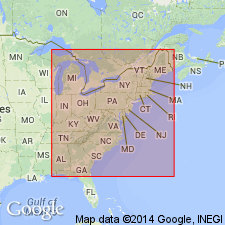
- Usage in publication:
-
- Joshua Rock Granite Gneiss*
- Modifications:
-
- Geochronologic dating
- Age modified
- Revised
- AAPG geologic province:
-
- New England province
Summary:
Revised as Joshua Rock Granite Gneiss. Clearly intrudes New London Gneiss and contains xenoliths of New London Gneiss as seen in new exposures at Crystal Shopping Mall on CT Rte 85 northwest of New London, CT. Exhibits anomalous U-Pb zircon isotopic systematics that leave considerable uncertainty as to its age. Tectonically constrained minimum age is earliest Permian (>280 Ma) and petrologically constrained maximum age is Middle Devonian (or, less likely, Late Ordovician). An intermediate Carboniferous age cannot be ruled out [based on 207Pb/206Pb dates ranging from 326 to 280 Ma]. Therefore, age is changed to Middle Devonian to Carboniferous.
Source: GNU records (USGS DDS-6; Reston GNULEX).

- Usage in publication:
-
- Joshua Rock Granite Gneiss
- Modifications:
-
- Overview
- Dominant lithology:
-
- Granite
- Gneiss
- AAPG geologic province:
-
- New England province
Summary:
Age of the Joshua Rock Granite Gneiss is loosely bracketed between the "tectonically constrained minimum age of earliest Permian and the petrologically suggested Middle Devonian." Intermediate Carboniferous age is possible based on possible link with the Quincy Granite (344 Ma) of RI. Age span given as c. 380 to c. 280 Ma. Authors note that Mississippian age may be preferable. Intrudes the New London Gneiss and is described as gray, weakly foliated, even-grained, medium-grained, aegirine-augite-bearing quartz-albite-microperthite granite. Contains rare-earth-bearing sphene and spots of cherry-red hematite on weathered surface.
Source: GNU records (USGS DDS-6; Reston GNULEX).

- Usage in publication:
-
- Joshua Rock Granite Gneiss*
- Modifications:
-
- Revised
- AAPG geologic province:
-
- New England province
Summary:
Use of Granite Gneiss as rank term follows that of Zartman and others (1988, American Journal of Science v. 288, p. 376-402).
Source: GNU records (USGS DDS-6; Reston GNULEX).
For more information, please contact Nancy Stamm, Geologic Names Committee Secretary.
Asterisk (*) indicates published by U.S. Geological Survey authors.
"No current usage" (†) implies that a name has been abandoned or has fallen into disuse. Former usage and, if known, replacement name given in parentheses ( ).
Slash (/) indicates name conflicts with nomenclatural guidelines (CSN, 1933; ACSN, 1961, 1970; NACSN, 1983, 2005, 2021). May be explained within brackets ([ ]).

